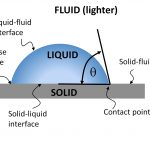Since the invention of froth flotation in 19th century, many laboratories are committed to both fundamental and applied research on collection of particles by dispersed gas bubbles in aqueous solutions of electrolytes, especially those working on processing of natural resources. However, in spite of tremendous progress made in characterization of particles and their surfaces and understanding the particle-bubble interactions, supported with detailed recordings of gas bubble attachments to both bulk specimens and particles, the flotation process remains poorly correlated with the wetting characteristics of particle surfaces. In fact, the contact angles used frequently to describe wettability of mineral surfaces remain among the most controversial, misunderstood and misinterpreted values in mineral processing literature. Contrary to wide-ranging beliefs, in the new contribution by Prof. Drelich (Michigan Tech) and Prof. Marmur (Technion, Israel) argue that neither the methodology of contact angle measurements nor selection of contact angles important to the particle flotation process are properly executed when analyzing flotation process. In their new paper published in Surface Innovations and entitled Meaningful contact angles in flotation systems: critical analysis and recommendations, the authors provide a brief personal prospective on some of the misconceptions on contact angles and the importance of additional fundamental studies in the area of mineral particles flotation.
Functional materials/surfaces, bioabsorbable materials, and natural minerals
Formulation, separation, processing, characterization, and application
-
Recent Posts
Archives
- August 2022
- June 2022
- May 2022
- December 2021
- July 2021
- March 2021
- January 2021
- December 2020
- November 2020
- July 2020
- March 2020
- February 2020
- December 2019
- November 2019
- September 2019
- August 2019
- July 2019
- June 2019
- May 2019
- April 2019
- March 2019
- February 2019
- January 2019
- December 2018
- November 2018
- August 2018
- July 2018
- June 2018
- April 2018
- March 2018
- February 2018
- January 2018
- December 2017
- November 2017
- October 2017
- September 2017
- August 2017
- July 2017
- June 2017
- May 2017
- April 2017
- March 2017
- February 2017
- January 2017
- December 2016
- November 2016
- October 2016
- September 2016
- August 2016
- July 2016
- June 2016
- May 2016
- April 2016
- March 2016
- February 2016
- January 2016
- December 2015
- November 2015
- October 2015
- September 2015
- August 2015
- July 2015
- June 2015
- May 2015
- April 2015
- March 2015
- February 2015
- December 2014
- November 2014
- October 2014
- September 2014
- April 2014
- January 2014
- October 2013
- July 2013
- June 2013
- May 2013
- April 2013
- March 2013
Categories

